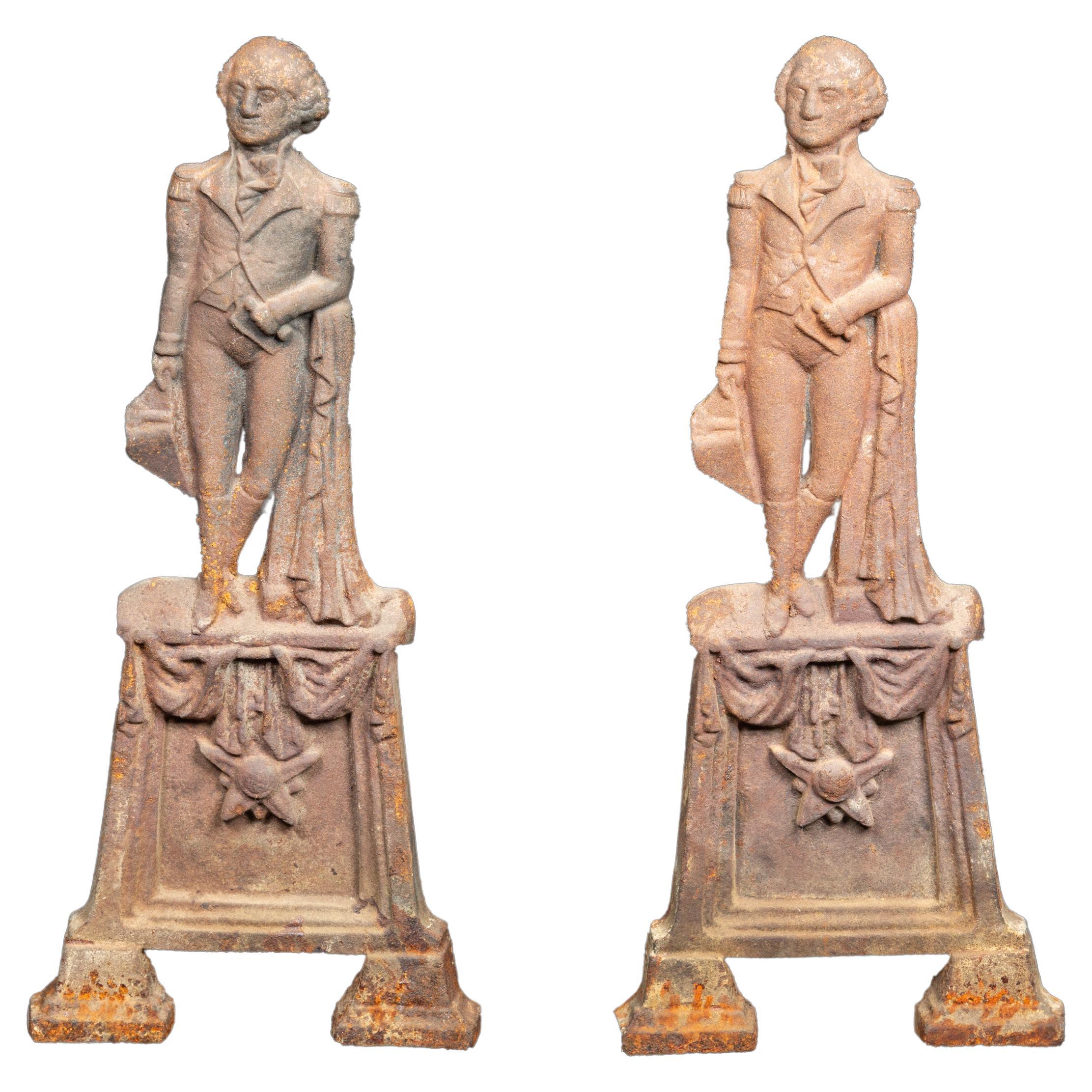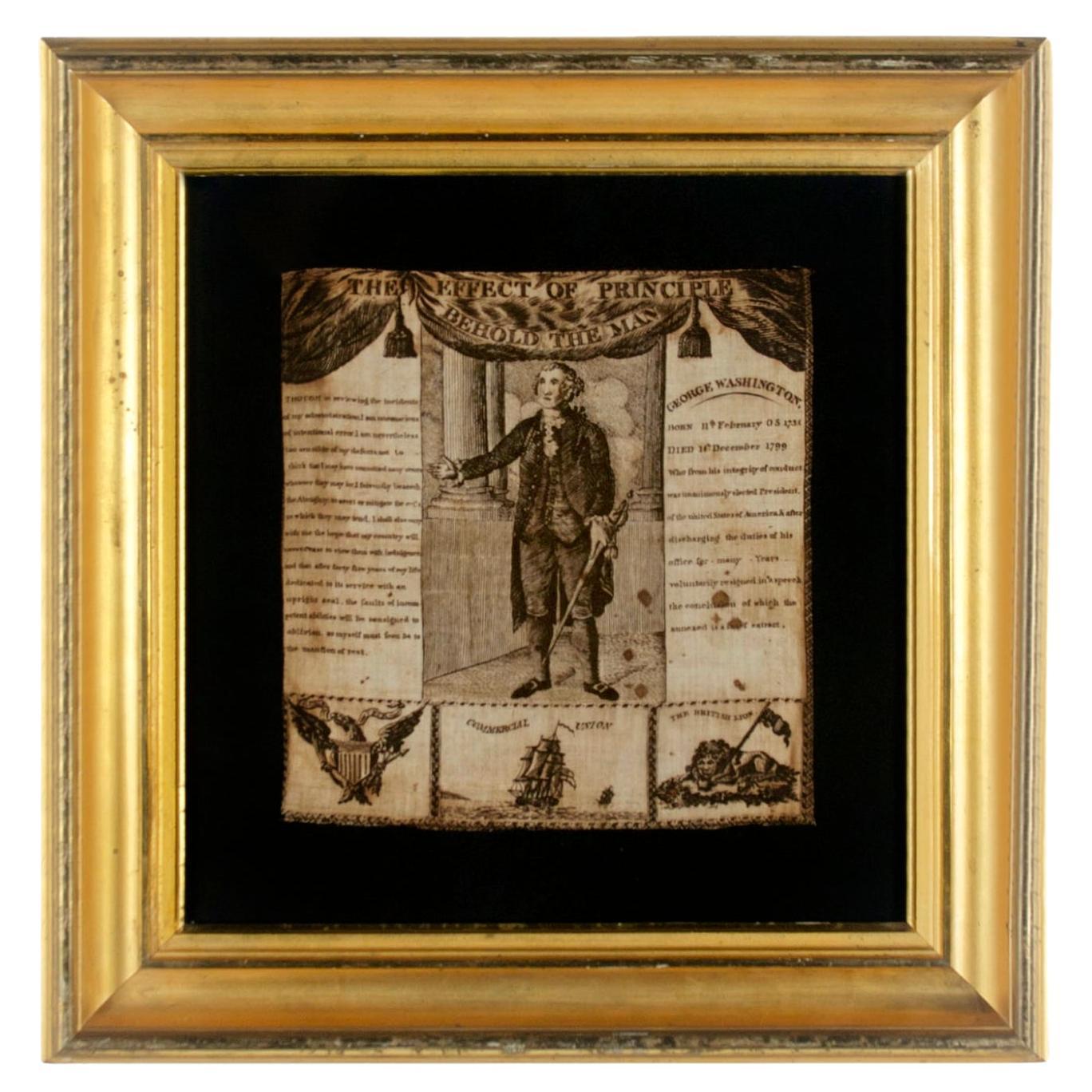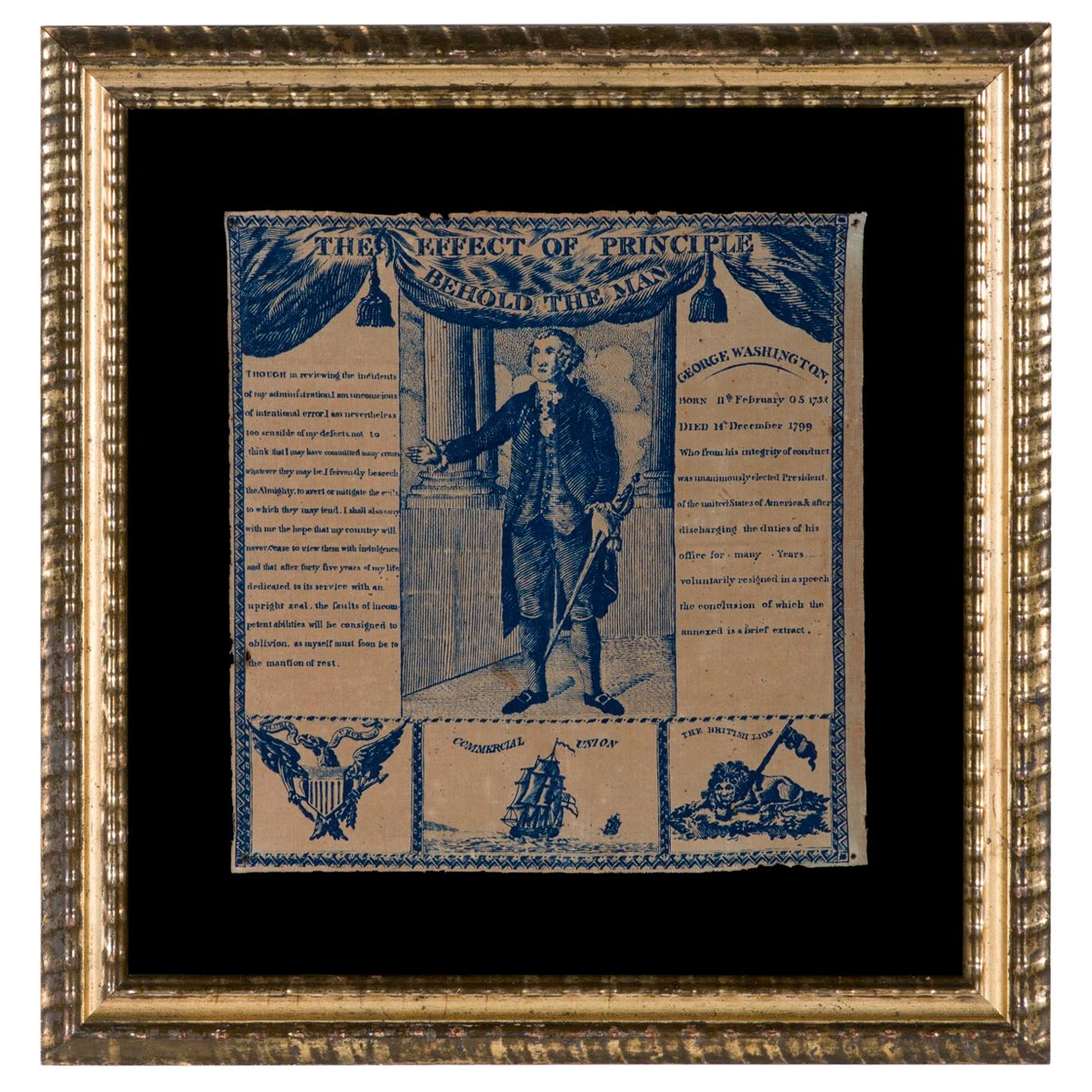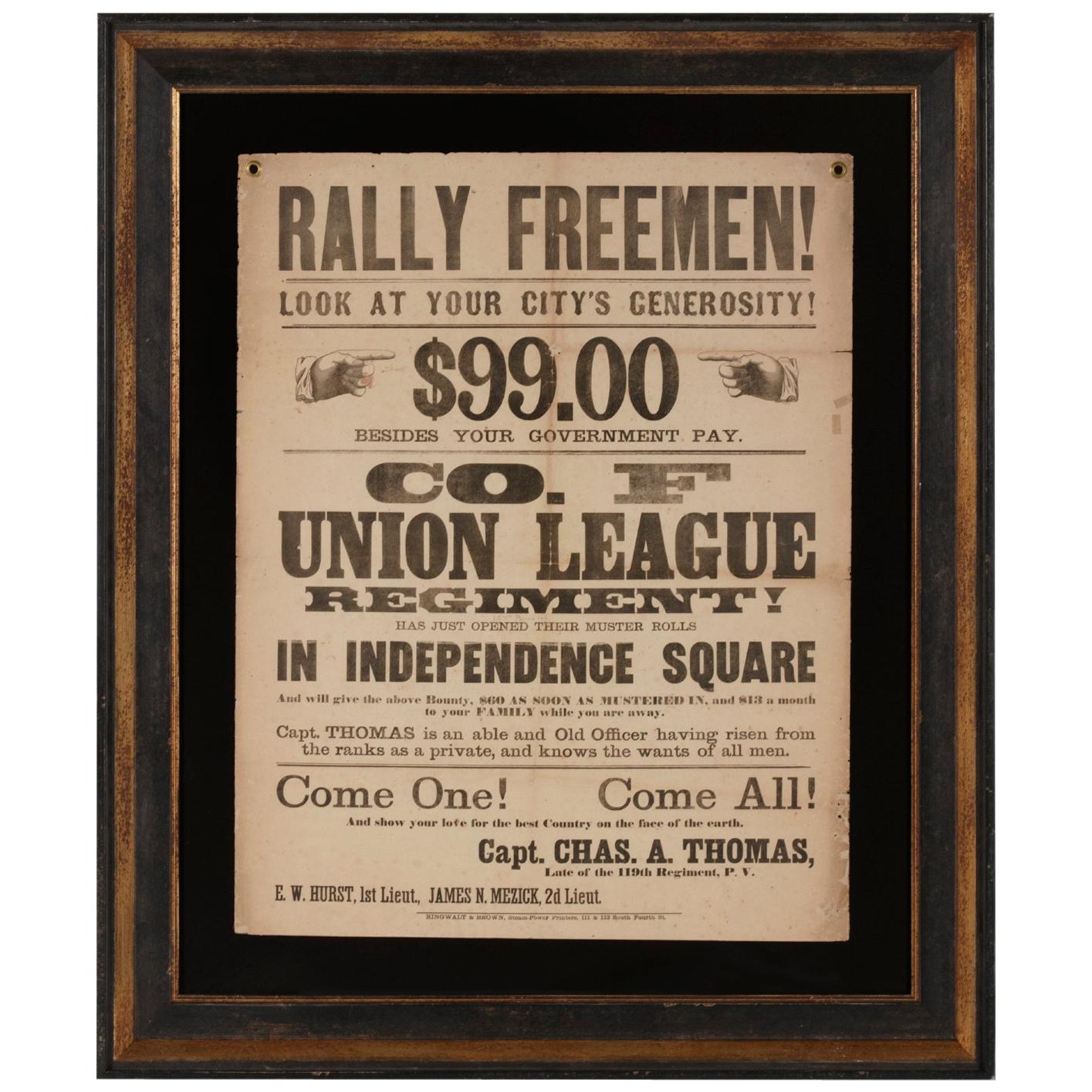Items Similar to Antique Silk Broadside An Elegiac Poem Death of President George Washington 1800
Want more images or videos?
Request additional images or videos from the seller
1 of 9
Antique Silk Broadside An Elegiac Poem Death of President George Washington 1800
About the Item
An important & rare antique American political printed silk broadside, an elegy on the death of President George Washington, dated 1800.
A poem on the Death of President George Washington January 1, 1800, see "Threads of History" No. 18, Shown P. 56.
January 1, 1800-Dated Federal Period, Memorial Poem Silk Broadside, Printed in black on fine off-white Silk, entitled:
"An Elegiac Poem on the Death of General George Washington Commander in Chief of the Armies of the United States. Dedicated To The Patrons of The True American. at the commencement of the year 1800".
This very rare original early printed cream colored silk textile is listed in the major reference book, "Threads of History," Americana recorded on cloth, 1775 to the present, published by the Smithsonian Institution, and listed as Item number 18 on page 56.
The silk and printing is in remarkable condition, having a few scattered minor stains, could be easily cleaned by a textile conservator. All the text is clear and fully readable, there are no splits to the silk, one very tiny hole lower left. It is remarkable that any example has survived to this date, especially in as good condition as this copy is.
An exceedingly rare and historic General George Washington memorial tribute a very rare commemorative item & one of the very earliest of all American Printed Historical Textiles. Issued in the wake of George Washington's death on December 14th, 1799, this printed poem is presented in a three vertical column format of text, displayed within a pair of outer decorative pediment columns with trailing floral decoration. To the top of each column is a funerary urn, above the arch & introductory text are cannons with the flags of the Republic & cherubs playing a harp. This remarkable printed textile is period to Washington's death & dated 1800", a rare & important piece of Americana.
- Dimensions:Height: 20.5 in (52.07 cm)Width: 13 in (33.02 cm)Depth: 1 in (2.54 cm)
- Style:Federal (Of the Period)
- Materials and Techniques:
- Period:1790-1799
- Date of Manufacture:1800
- Condition:Wear consistent with age and use. Housed under glass in a 19th century period primitive frame.
- Seller Location:Portland, OR
- Reference Number:1stDibs: LU4876138197492
About the Seller
5.0
Platinum Seller
These expertly vetted sellers are 1stDibs' most experienced sellers and are rated highest by our customers.
Established in 2000
1stDibs seller since 2019
255 sales on 1stDibs
Typical response time: 2 hours
- ShippingRetrieving quote...Ships From: Portland, OR
- Return PolicyA return for this item may be initiated within 7 days of delivery.
More From This SellerView All
- Antique Brass & Pietra Dura Portrait Miniature Painting George Washington 1880Located in Portland, ORA fine, antique brass easel with Pietra Dura panels and three handpainted portrait miniature paintings, circa 1880. The brass easel of triangular ...Category
Antique 1880s American American Empire Paintings
MaterialsBrass
- Antique Irish George III Chippendale Mahogany Serving Table/SideboardLocated in Portland, ORAn important antique Irish George III Chippendale mahogany serving table/sideboard, circa 1770. The table made from the finest Cuban mahogany, having a serpentine shaped front with a...Category
Antique 18th Century Irish George III Sideboards
MaterialsMahogany
- Antique 19th Century Indian Hindu Copper Sacred Nandi Bull Water Vessel 1800Located in Portland, ORAn antique Indian Hindu copper Nandi (bull) lidded and handled water vessel, circa 1800. In the Hindu faith & culture of India the bull is a sacred animal, the term Nandi means "giving joy" or "delight", the Nandi is the scared bull of one of the most important gods, Shiva, the bull is also Shiva's animal form and also his transport. This vessel is finely crafted from copper and has a circular lid and hinged handle, the vessel is modeled as a bull by hand hammering using...Category
Antique Early 1800s Indian Anglo-Indian Metalwork
MaterialsCopper
- Antique Georgian George II Figured Walnut Bookcase Bureau Secretary Desk, 1750Located in Portland, ORA very fine antique George II figured and inlaid walnut bureau bookcase/secretary, circa 1750. The bookcase secretary in two secrions, the upper bookcase having a stepped crown with twin arched mirrored doors below, the mirror to the right side having a reversed engraved flower and the doors enclosing three adjustable shelves. The base having a fall front with a fitted writing surface, the interior is extravagantly fitted with eight pigeonholes, six drawers with a central carved arched door flanked with ribbed columns. The door having a secret switch to the inside allowing the whole 'box' to be withdrawn, therefore providing access to two secret drawers to the verso. The base having twin pull-out lopers to support the fall front, below are four long and two short drawers, the cabinet is raised on bracket feet. The bookcase secretary is made from the finest figured walnut which is crossbanded & inlaid with satinwood stringing, the cabinet has all the original brass handles, lockplates/escutcheons. This is a very fine quality early Georgian bookcase secretary...Category
Antique 1750s English George II Bookcases
MaterialsWalnut
- Antique Georgian George III Chippendale Mahogany 3-Tier Dumb Waiter, circa 1760Located in Portland, ORAntique Georgian George III Chippendale mahogany 3-tier Dumb waiter, circa 1760. The dumb waiter made of the finest solid mahogany and having three graduated 'dish top' serving tiers...Category
Antique Mid-18th Century English Chippendale Serving Tables
MaterialsMahogany
- Antique Pair Regency George IV Neo-Classical Architectural Mahogany Hall ChairsLocated in Portland, ORA good pair of antique Regency carved mahogany hall chairs, in the Neo-Classical style, 1830's. The chairs having an architectural twin 'Swan's Neck' pediment to the top & flanking a...Category
Antique 1830s English Neoclassical Chairs
MaterialsMahogany
You May Also Like
- Patriotic Silk Kerchief w/ 34 Star Flags & an Image of Washington, Civil War EraLocated in York County, PAPATRIOTIC SILK KERCHIEF OF THE CIVIL WAR PERIOD, WITH AN ENGRAVED IMAGE OF GEORGE WASHINGTON, CROSSED 34 STAR FLAGS, AN EAGLE, AND "UNION FOREVER" SLOGAN: Patriotic kerchiefs that date prior to the 1876 Centennial of American Independence are rare among surviving 19th century textiles. Printed on silk and made during the opening years of the Civil War, this example consists of a white ground with red and blue borders. Inside is a prominent, copper engraved, device that consists of a large image of George Washington, crowned by a spread winged eagle that grasps a billowing streamer in its beak and talons. The ribbon boasts the Federal sentiment "Union Forever." The likeness of Washington is derived from Gilbert Stuart's Athenaeum portrait. Below this is a facsimile of Washington's signature, cradled by crossed American flags, each with 34 stars arranged in circular medallions. Although political textile historian Herbert Ridgway Collins associated this kerchief with the centennial of American independence,* there is overwhelming evidence that it was produced earlier. The large scale is much more indicative of kerchiefs produced in the 1860's and prior. Made of silk, the binding is hand-stitched, which is also common of those produced before 1876. When these facts are added to the pro-Union Civil War slogan and flags in the 34 star count, the combination of all these factors points firmly to Civil War period manufacture. Kansas was admitted into the Union as the 34th state on January 29th, 1861, about two-and-a-half months before the Confederate assault on Fort Sumter that marked the beginning of the Civil War. The 34th star was officially added on July 4th of that year and the star count remained official until July 4th, 1863. Further evidence can be found in an example of this kerchief that resides in the collection of the Adams County, Pennsylvania Historical Society, with firm provenance to a woman by the name of Emma Yount. The story goes like this: “With the Battle of Gettysburg looming and the countryside in turmoil, the Union cavalry rode into Gettysburg on the afternoon of June 30, 1863. The troopers dismounted and lounged in the town while awaiting further orders. During that time, the seven year old daughter of innkeeper Israel Yount, Emma, was playing outside their home when a cavalryman asked her to come and visit with him while he was resting. The cavalryman told her that he missed his young daughter at home and asked if little Emma would hug and kiss him on the cheek to remind him of his daughter, who he felt he might not ever see again. Emma asked her mother if she could do as the cavalryman suggested, and her mother considered the circumstances and allowed Emma to do so. Before leaving, the cavalryman gave young Emma a silk handkerchief he was carrying that featured George Washington's image and patriotic border and flags. Emma kept that handkerchief until her death in 1946 and it was then donated to the Adams County Historical Society.” The trio of brass rings, hand-sewn along the top edge, would have been added by a former owner so that it could be hung vertically. The textile itself is both beautiful in design and rare. Outside of an example pictured by Collins in his book “Threads of History” (Smithsonian Press, 1979), and the copy in the Adams County Historical Society, only three others like it are known to have surfaced, including this example. This condition is excellent for the period and it survives as an exceptional relic of the War Between the States. It is of interest to note that kerchief bears marked similarities to another, especially rare, pro-Union variety, that was produced in London for the American market. Notably larger in scale, but very much alike in terms of the fabric, the printing, the shades of red and blue, the verbiage, and the general overall graphic feel, it was produced by Foster & Porter, a known, English maker of printed kerchiefs. Instead of featuring George Washington, the imagery centers on a large cannon...Category
Antique 1860s American Political and Patriotic Memorabilia
MaterialsSilk
- Pair of Cast Iron George Washington Figural AndironsLocated in New York, NYPair of cast iron George Washington Andirons: Measures: 9" x 20" x 16" Weighs: 30 LBS.Category
Early 20th Century American American Classical Andirons
MaterialsIron
- Printed Linen Kerchief of George Washington, ca 1806, Germantown, PALocated in York County, PAExtraordinarily early (1806) printed linen kerchief glorifying George Washington, Germantown print works, Germantown, Pennsylvania Printed in sepia ink on coarse, white linen, this patriotic kerchief shows a standing portrait of George Washington, above which is a swag valance and the words “The Effect of Principle, Behold the Man”. The portrait is based on a mezzotint after Gilbert Stuart’s very famous painting of Washington in his later years. Stuart painted it in oil on canvas for a wealthy merchant by the name of William Constable, who commissioned the work for Alexander Hamilton. The kerchief is interesting because it is both American-made and documented. This is exceptionally unusual for any printed textile of the 19th century or prior and the earlier the time period the more unlikely an object is to be identified. This kerchief and a companion piece entitled “The Love of Truth Mark the Boy” (also glorifying Washington through the fabled story of the cherry tree), were made ca 1806 by Germantown Print Works in Germantown, Pennsylvania. To the left of Washington's image is a portion of his infamous farewell address to his troops at the end of the Revolutionary War. To the right is a short excerpt from his eulogy. Below these are three images. In the center is a square-rigged tall ship with “Commercial Union” above it, flanked by the American eagle on the left and the British lion...Category
Antique Early 19th Century American Political and Patriotic Memorabilia
MaterialsLinen
- 1806 Printed Linen Kerchief Glorifying George Washington, Germantown, PennLocated in York County, PAEXTRAORDINARILY EARLY (1806) PRINTED LINEN KERCHIEF GLORIFYING GEORGE WASHINGTON, PRINT WORKS, GERMANTOWN, PENNSYLVANIA Printed in blue ink on coarse, white linen, this patriotic kerchief shows a standing portrait of George Washington, above which is a swag valance and the words “The Effect of Principle, Behold the Man”. The portrait is based on a mezzotint after Gilbert Stuart’s very famous painting of Washington in his later years, most often referred to as the Landsdowne portrait. Stuart painted three versions of it in oil on canvas, one of which was completed in 1796 for a wealthy merchant by the name of William Constable, who commissioned the work for Alexander Hamilton. The kerchief is interesting because it is both American-made and documented. This is exceptionally unusual for any printed textile of the 19th century or prior and the earlier the time period the more unlikely an object is to be identified. This kerchief and a companion piece entitled “The Love of Truth Mark the Boy” (also glorifying Washington, through the fabled story of the cherry tree), were made circa 1806 by Germantown Print Works in Germantown, Pennsylvania. To the left of Washington's image is a portion of his infamous farewell address to his troops at the end of the Revolutionary War. To the right is a short excerpt from his eulogy. Below these are three images. In the center is a square-rigged tall ship with “Commercial Union” above it, flanked by the American eagle on the left and the British lion on the right. It is reasonable to assume that the textile may have been produced in demonstration of the maker's desire, and/or that of others, to advance trade with England. Commercial printers were very influential in early America, as they possessed the means by which to disseminate information. This kerchief and its companion piece are documented in Threads of History, Americana Recorded on Cloth, 1775 - the Present, by Herbert Ridgeway Collins (1979, Smithsonian Press), p. 63, items 38 & 39.* The two pieces pictured are in the collection of Cornell University, but the Collins text also cites an uncut pair to be present in the collection of the Western Reserve Historical Society, Cleveland, OH. The name "Germantown Print Works" is printed on the Western Reserve examples. Another example of the textile in question is documented in "Running for President, The Candidates and Their Images, 1789-1896" by Schlesinger, Israel, and Frendt, (1994, Simon & Schuster), p. 15. I have seen three different color variations of this textile, including sepia, mulberry red, and blue. This particular example has a hand-sewn binding along the top, lower, and left edges. Mounting: The textile was mounted and framed within our own conservation department, which is led by expert staff. We take great care in the mounting and preservation of flags and have framed thousands of examples. The gilded molding has a rippled profile and dates to the period between 1825 and 1850.The background is 100% cotton twill, black in color. The glazing is U.V. protective plexiglass. Feel free to contact us for more details. Condition: There is an all-over golden oxidation of the white fabric and there is very minor staining. There are tiny tack holes in each corner and there are minor nicks around the perimeter. * Collins relates that Germantown Printworks was operated by the Hewsons. In doing so he cites one of Worthington Chauncey Ford's books on George Washington, but it isn't clear which one (there are many) and no page numbers are given. John Hewson was an Englishman who came to America and opened his printing business on the advice of Benjamin Franklin. He was one of the first “calico printers” and is the earliest documented to have advertised printed kerchiefs. His ads for bandanas appear as early as June 20th, 1774. He is suspected of having produced the very first American kerchief that pictured an American president, which is documented in Collins as item 1 on page 48. Linda Eaton, curator at Winterthur, in 2012, is currently doing in depth research on the three printers of fabrics that were operating in Germantown in early America. She discovered that the owner and/or operator of Germantown Print Works, while not currently known, was not John Hewson. This information is not yet published. She also noted that Winterthur possessed examples of the two George Washington textiles...Category
Antique Early 1800s American Political and Patriotic Memorabilia
MaterialsCotton
- "Rally Freemen!..." Civil War Recruitment BroadsideLocated in York County, PA"RALLY FREEMEN! …COME ONE! COME ALL! AND SHOW YOUR LOVE FOR THE BEST COUNTRY ON THE FACE OF THE EARTH." A CIVIL WAR RECRUITMENT BROADSIDE FOR THE...Category
Antique 1860s American Political and Patriotic Memorabilia
MaterialsPaper
- Antique American Flag w/ Hand-Written Inscriptions Mourning the Death of FDRLocated in York County, PA48 STARS ON ANTIQUE AMERICAN FLAG WITH HAND-WRITTEN INSCRIPTIONS AND AN EMBROIDERED DATE OF APRIL 12TH, 1945, MOURNING THE DEATH OF PRESIDENT FRANKLIN DELANO ROOSEVELT: American national parade flag with 48 stars, printed on cotton, embellished with hand-written inscriptions and an embroidered date to commemorate the death of FDR on April 12th, 1945. “On this day in 1945, President Franklin D. Roosevelt died of a massive cerebral hemorrhage at his Warm Springs, Georgia, retreat at the age of 63. Roosevelt’s death in the final months of World War II was met with shock and grief throughout the Western world. Many Americans had no inkling of his decline in health. [He] had been president for more than 12 years, longer than any other person. He led the country through some of its greatest domestic and foreign crises to the impending defeat of Nazi Germany and within sight of Japan’s surrender...Category
Vintage 1940s American Political and Patriotic Memorabilia
MaterialsCotton
Recently Viewed
View AllMore Ways To Browse
Sergeant Sailor
Wilson Brothers Items
G Sergeant Antiques
Wreath Outdoor
Distressed Debt
Folk Art Felt Pennant
Antique American Flag 49 Stars
California Republic Vintage Flag
Chinese Porcelain Lunch Box
Toy Sewing Machine
Uss Utah
A Moderate Gale
Antique Jewelry Lancaster Pa
Carved Wood Birds
Eagle Of The French National Guard
Grand Duchess Tatiana
Hermes Folk Art Scarf
Hermes Scarf Folk





